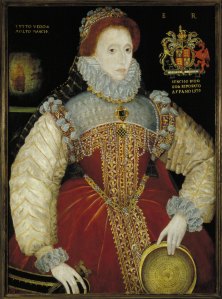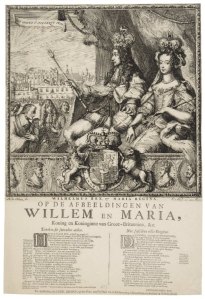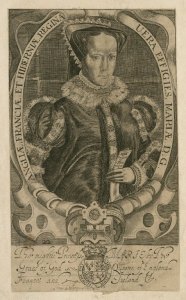
Louis Butelli
Hello once again from your pal Louis Butelli. Here at Folger Theatre, we are currently two weeks into our rehearsal period for Friedrich Schiller’s play Mary Stuart, which begins previews on January 27. We’re having great fun so far – with Peter Oswald’s excellent translation of the play, the fabulous Richard Clifford at the helm as director, and stellar actresses Kate Eastwood Norris and Holly Twyford as the central characters, I think this show will knock your socks off. Why not click here now for your tickets??
First produced in Germany in 1800, the play tells the story of Mary Stuart, the former Queen of Scotland and Queen Consort of France, who has been imprisoned in England by her cousin Queen Elizabeth I, ostensibly due to suspicious circumstances surrounding the murder of her husband, Lord Darnley. More pertinently, perhaps, the Catholic Mary also has a legitimate familial claim to the English throne, currently under the Protestant Elizabeth.
Any time the political and the religious merge on the popular stage, or so it seems in the year 2015, a kind of murderous mania can be the result. A dilemma, to be certain! How do international leaders, particularly those who have inherited their positions and must constantly fight off usurpers and schemers to keep them, hold their nations together? How does any nation stay together, ever? What is it to rule? At what point, if ever, does one simply give up?
With the action moving between Fotheringhay Castle, where Mary is being held prisoner, and Elizabeth’s Court at Westminster Palace in London, Mary Stuart takes us inside the minds of two incredible women of power. Audiences will experience the two Queens as they engage in psychological chess-matches with lesser men – men who flatter and scramble for the favor of the Queens while they simultaneously plot to deceive the women and advance themselves. Only one of the women can live. History already tells us the answer – Mary Stuart walks us along towards its inexorable conclusion on the chopping block.
Confused yet? I certainly was!
For one thing, most of us who share an interest in William Shakespeare, his work and his life and times are well aware of Elizabeth I. Daughter of Henry VIII and Anne Boleyn, Elizabeth reigned for 45 years, created an Empire, and was Shakespeare’s great patroness, often seeming inextricable from his work. For modern scholars, the entire period encompassing Shakespeare and his contemporaries is still termed the “Elizabethan” period. More prosaically, the past few decades have seen a fair number of popular movies with Elizabeth I as a central figure, attracting the talents of such actresses as Glenda Jackson, Cate Blanchett, and Judi Dench.
I am no scholar of the British monarchy. I find the whole thing to be incredibly confusing, frankly, particularly when it comes to quarreling (and murder) between family lines, intermarrying (and war) between royal families of other nations, and the fact that there have been many simultaneous kingdoms in the “United Kingdom” over many centuries. Here in the States, when we think of “Britain,” I imagine we often forget that the term has come to include the fiercely independent nations of Scotland, Ireland and Wales.
When one invokes the name “Mary,” as regards to the British monarchy, one could easily think “Bloody Mary,” or “Mary Queen of Scots,” or “William and Mary.” Correct! All three of these Marys existed and were, in one way or another, Queen. For the record, the Mary in our play Mary Stuart is indeed “Mary, Queen of Scots,” or “Queen Mary I of Scotland.”
This is still confusing. Let us consider the English monarchy itself for just a moment.
Like any institution that stays with us for many centuries, the monarchy is shrouded in mystery. If one were to ask an American the most famous British king, I imagine the name Arthur would come up. Ostensibly a Welshman, he has been named in folklore and popular culture alike and, though his deeds and his existence itself have been questioned, he has been revered as a national hero since the turn of the 6th century AD.
He was certainly not the first: his father, the even more mythical Uther Pendragon, is named frequently alongside any mention of Arthur. Moreover, these men allegedly held close counsel with a wizard, grappled with the intercession of gods and ghouls, and had a magic sword at their disposal.
In this sense, the monarchy is as much an origin story as the works of the blind poet Homer, or the Bible, or Star Wars: Episode 6. Where else but in popular mythology would one encounter a king called “Ethelred II the Unready?”
I wondered what the current Royal Family had to say about such things. Conveniently, they have a website! If these sorts of things interest you, I suggest that you click to read about “The History of the Monarchy,” from the on-line perspective of the Royal Family in 2015.
To summarize: if popular wisdom is to be believed, there have been 62 hereditary monarchs in England since King Offa reigned from 757-796AD, to say nothing of the 43-ish Scots monarchs (Mary Stuart was among them for 25 years before the action of our play takes place), or the 19 Welsh monarchs, not including Arthur and Uther. In England, Queen Elizabeth I clocks in at number 44, while her distant relative in Great Britain, Queen Elizabeth II, 1st cousin, 13 times removed, it is thought, is number 62.
For perspective: Barack Obama is the 44th President of the United States. Prince George of Cambridge, who will turn 2 years old next July, is third in line to become the 63rd hereditary monarch of England and Great Britain. His father HRH Prince William of Wales and his mother Kate, the Duke and Duchess of Cambridge, recently spent a lovely and well-documented evening meeting up with Beyoncé and Jay-Z at the Barclay Center in Brooklyn, New York.
In times of great economic disparity, in times wherein we wonder who might be piloting the ship of state, whatever state that might be, in times of political, social and religious assassinations, I believe that people might wonder about the thought processes of those in charge. That is what Mary Stuart is about. Please come and see it, and let’s go talk about these things over a cocktail afterwards.
Here’s to a brand new Congress, recently in session, and here’s to public discourse, history, scholarship, and live theater!
My old posts are here, and you can follow me on Twitter here.
Stay connected
Enter your email address to follow this blog and receive notifications of new posts by email.





